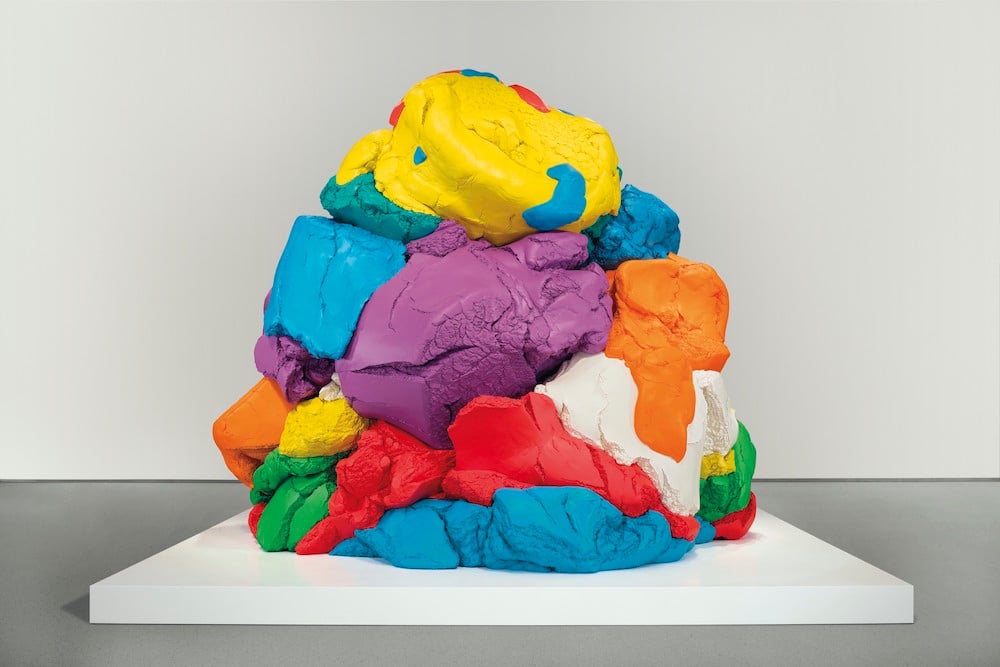Auctions
Jeff Koons’s Giant Play-Doh Sculpture Could Fetch $20 Million at Christie’s This Spring
The sculpture took around two decades to produce.

The sculpture took around two decades to produce.

When the Whitney Museum of American Art staged its blockbuster retrospective of Jeff Koons in 2014, the most photographed work was undeniably Play-Doh (1994–2014), an 11-foot-tall aluminum sculpture that looked as if an artistic young giant had created a multicolored pile of clay and then left it behind.
Now, a version of that candy-hued work is heading to auction. Christie’s will offer an edition of Play-Doh at its evening sale of postwar and contemporary art in New York on May 17. The work, consigned from a European collection, is expected to sell for a price “in the region of $20 million.” This marks the first time that a Play-Doh sculpture, one of five unique versions from the artist’s notoriously ambitious and pricey “Celebration” series (each one featuring a different sequence of colors), has come up for auction.
By the time Koons finally revealed Play-Doh to the public in his Whitney retrospective, it was already the stuff of legend. The work took around two decades to produce as the notoriously perfectionist Koons fiddled with the medium and refined the production process. (The owners of the version shown at the Whitney, LA-based collectors Bill and Maria Bell, originally committed to buying the work in 2005, and continued to fund it as Koons ironed out the kinks for the next decade.)
It took decades for the notoriously perfectionist Koons to generate the sculpture’s unique cracked texture, which, in the final version, really does look like the dried surface of play-doh.
But that wasn’t the only engineering challenge. Rather than opt for a hollow sculpture, which would have drastically cut down on the production time and cost, Koons insisted on creating a real “pile.” From a plaster mold, Koons’s team created more than two dozen interlocking sections of painted aluminum that are designed to fit together perfectly. Gravity alone holds the blocks in place.
“It took years for Jeff to get to a point where he felt like the original sculpture was finished,” said Andrew Pharmer, who worked with Koons’s studio on the project at the famed Polich Tallix foundry in Walden, New York. “The cracks really have to be done by hand and by eye—that’s part of what took so long. It’s really as tedious as you can imagine.” But, he added, “if it were to be fabricated in a single section, it would be a completely different sculpture. You would see a bleed between the colors.”
The massive work also posed considerable logistical hurdles for Christie’s, and ranks among the most ambitious installations the house has ever undertaken at its Rockefeller Center headquarters. Though it arrives in pieces, the assembled sculpture is approximately 12 by 10 feet, and the doors had to be widened to accommodate it. Art handlers used a spider crane—specifically designed for indoor and small-space use—to get the moving parts in place. “We hope that part of the magic of viewing this work will be the question: ‘How did they get that in here?'” says a Christie’s spokesperson.
It will be on public view from April 13 to April 19, April 28 to May 5, and again during 20th Century week leading up to the auction (May 12–17).
Koons has said inspiration for the work struck in the ’90s, when he was in Rome with his toddler son Ludwig. “[H]e made a mound of play-doh and he said ‘Dad!’ and I turned, ‘What?’ And he went, ‘Voila!’ in front of the mound of play-doh,” Koons told the New Yorker in 2007. “And he was so proud. And I looked at it and I thought, you know this is really what I try to do every day as an artist, to make objects that you can’t make any judgements about.”
If it meets the $20 million low estimate, Play-Doh will be among the highest prices at auction ever achieved for work by Koons. But a new record is not likely. That slot is held by Balloon Dog (Orange) (1994–2000), which was consigned by Peter Brant and sold for $58.4 million at Christie’s New York in 2013.
Additional reporting by Julia Halperin